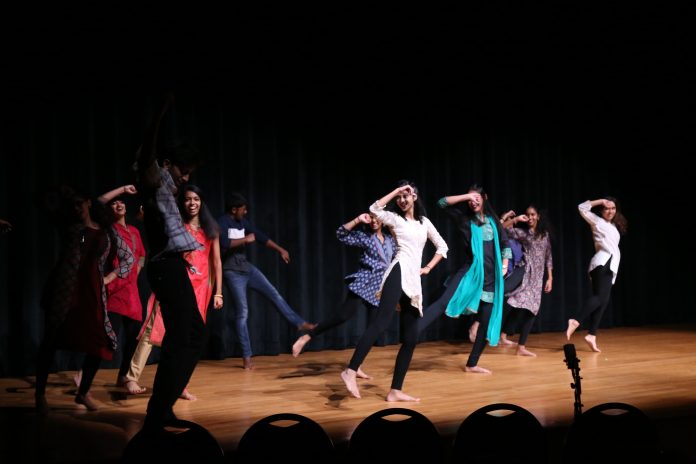As the lights dimmed in Commonwealth Auditorium Saturday, Nov. 2, students settled in for an evening of dance, poetry, and music as the South Asian Student Association put on their annual cultural exhibition, “Expressions.”
In a night packed full of performances, SASA highlighted the talents of its members. From fashion shows to group dances, spoken-word poetry and even a play, “Expressions” created an explosion of cultural celebration. While the exhibition gave a creative outlet to SASA members, it also allowed them to connect as a community on campus.
“I feel like the freshman class definitely bonded really well through this experience,” “Expressions” junior co-chair Aanchal Goenka ’23 said. “As a class, we’re more reserved and quiet, and people only knew one or two people. But doing the freshman dance, especially when it was a lot of people’s first time dancing, we kind of bonded over that, and now I feel like we’re really close together because of it.”
Leading up to the performance, SASA members spent hours choreographing and rehearsing their performances, which only brought everyone closer together.
“In a short duration, we were spending hours together,” “Expressions” co-director Easha Qasba ’22 said. “You’d end up getting meals with them, and it was like, wow, we have a lot more in common than you think you do.”
The rehearsals became a space of friendship and camaraderie.
“It was a lot of fun once you get there, and you’re hanging out with your friends,” Upasana Barot ’22, “Expressions” co-director, said. “Mostly everyone’s friends with each other on SASA, which is great. You get there, and it’s a great environment to relax after a long day of going to school and doing work.”
For students like Qasba, “Expressions” was also a valuable way to express her culture and share it with the community at the College of William and Mary.
“My high school was not very diverse at all,” Qasba said. “Coming from that school to here and getting involved in a Bollywood fusion dance team and ‘Expressions’ was like my counter to not really having that experience in high school. I had a community when I was growing up that was outside of school, and it was family friends that my parents had built a community with, and that was something that I really valued, because when you don’t have family nearby, you kind of create a family with the community around you, so this is what SASA has allowed me to do on campus.”
Barot echoed this experience, describing Expressions as a means of displaying her cultural heritage.
“I didn’t go to a very diverse school either: the only two South Asians were my cousin and me, we were the only two in our grade,” Barot said. “Initially, when you live in a town that’s not as diverse, sometimes you’re more hesitant to embrace your identity, because you’re like, ‘oh people won’t understand,’ or they’ll judge you. But here, when we have such a big cultural showcase, I now look forward to embracing my identity and being like, ‘ok, this is our Indian show, this is our South Asian showcase, let’s embrace our identity, let’s dance to Bollywood songs and showcase our culture through our play and performances.’”
As an organization, SASA connects old and new members through their big-little program. For Goenka, her Big urged her to perform at “Expressions.”
“I feel like that made a big difference, too, because this was my first time embracing my culture in public,” Goenka said. “Where I come from, there’s not really many Indians or South Asians. So having a big that was embracing and motivating me gave me courage to actually dance for the first time.”
Although dances played a large role in the showcase, another important element was the play: a fusion of “Mean Girls” and Bollywood film “Kabhi Khushi Kabhie Gham.” The plot revolved around identity, with characters struggling between conformity and staying true to their own selves, and incorporated comedic elements.
“Last year, our play was a lot more serious; it was about mental health,” Barot said. “That was great, but this year we wanted to mix it up a little and have a balance, to make it more light-hearted, but we still wanted to have a message.”
Along with messages about identity, SASA members also wanted to send a message about social change. Proceeds from the Expressions showcase went towards Doctors for You, a South Asian charity that works to improve public health and hygiene. In addition to the ticket price, audience members could purchase raffle tickets, with proceeds going directly to charity.
“We weren’t sure how much of a profit the show itself would make, so from the charity aspect, we wanted to make sure that we had a significant amount to contribute, so doing the raffle was our way of doing that,” Qasba said. “It was nice to see people willing to donate on top of buying their ticket.”
Despite the serious themes of cultural unity and activism, Qasba emphasized another underlying theme of Expressions: having fun.
“It’s supposed to be light-hearted and fun, and it’s supposed to be a way to get to know your community and show the greater William and Mary and Williamsburg community what our culture is about,” Qasba said. “It doesn’t have to be something that’s super put together. Seeing people have fun with the culture, with the music, with the dances, that’s more important to us than having a perfectly synchronized dance.”

